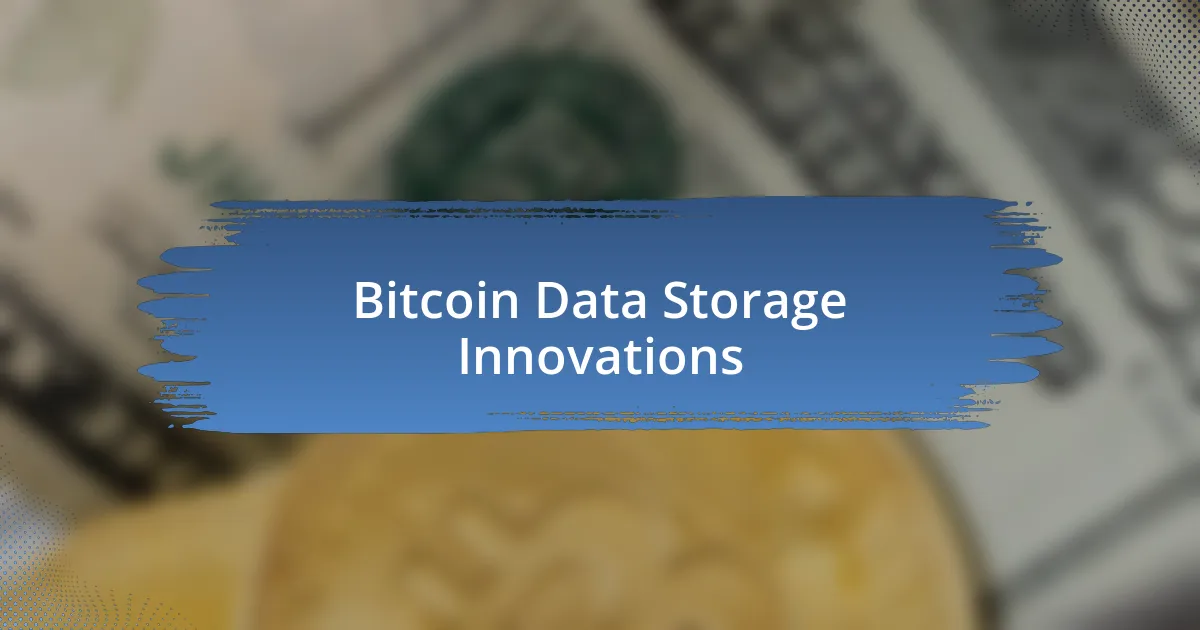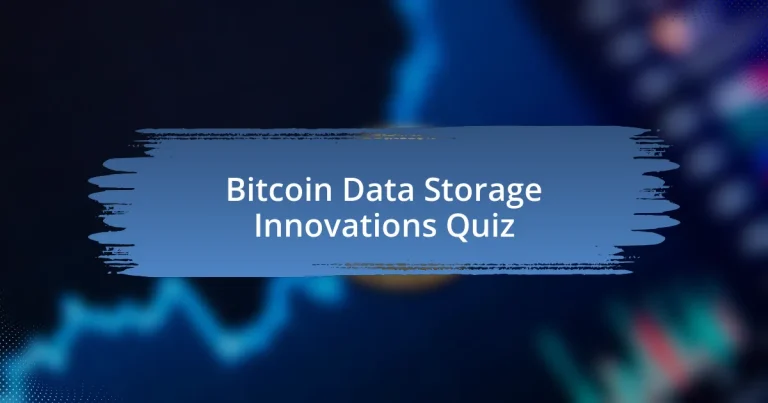
Start of Bitcoin Data Storage Innovations Quiz
1. What is the primary function of a decentralized cloud storage platform like Storj?
- Storj allows users to rent out their unused storage space, creating a peer-to-peer network.
- Storj provides video streaming services to users worldwide.
- Storj acts as a social media platform for file sharing.
- Storj is primarily used for cryptocurrency trading.
2. How does Filecoin incentivize users to provide storage space?
- Filecoin incentivizes users to provide storage space by compensating them for housing their files.
- Filecoin fines users who do not provide enough storage space.
- Filecoin encourages users to donate storage space without any rewards.
- Filecoin requires users to pay fees for using storage space.
3. What is the main advantage of using a cold wallet for cryptocurrency storage?
- Greater liquidity for quick trades.
- Increased transaction speeds in online wallets.
- Easier access from multiple devices.
- Higher security due to offline storage.
4. What is the name of the technology underlying Bitcoin?
- DataCloud
- HashChain
- Blockchain
- CryptoNet
5. How often can we expect a new block to be found by miners in the Bitcoin network?
- Every hour.
- Every 5 minutes.
- Every day.
- On average, every 10 minutes.
6. What is SHA 256?
- A data compression technique used to reduce file sizes.
- A software program used for managing databases effectively.
- A secure hashing algorithm used by Bitcoin, originally designed by the NSA.
- A type of encryption method used to secure files on a computer.
7. What is a nonce in the context of Bitcoin?
- An integer value that miners adjust to find a valid hash.
- A data packet sent during transaction processing.
- A timestamp that records when a block was created.
- A username used by miners in the network.
8. What is the purpose of using a hybrid storage solution combining traditional cloud storage with blockchain elements?
- To create a new form of cryptocurrency solely for cloud storage services.
- To leverage the best of both worlds—scalability and efficiency of cloud storage with the security and transparency of blockchain.
- To ensure that only one user has access to all data in the storage network.
- To store all data exclusively on local devices, preventing any cloud usage.
9. What is the InterPlanetary File System (IPFS)?
- A decentralized file system that provides a peer-to-peer method of storing and sharing hypermedia in a distributed file system.
- A software application for creating digital art.
- A type of cryptocurrency used for online transactions.
- A centralized cloud service for storing data in a single location.
10. What are the benefits of decentralized storage networks?
- Increased reliance on third parties, data vulnerability, and reduced efficiency.
- Lower data redundancy, single point of failure, and higher maintenance costs.
- Centralization of data, reduced privacy, increased costs, and limited access.
- Heightened security, privacy protection, improved resilience, cost-effectiveness, and user empowerment.
11. How does Filecoin ensure data integrity and availability?
- Filecoin requires centralized storage providers for data integrity and availability.
- Filecoin solely relies on user trust to ensure data integrity and availability.
- Filecoin uses only encryption methods for data integrity and availability.
- Filecoin uses a combination of Proof of Replication and Proof of Space-Time to ensure data integrity and availability.
12. What is the role of nodes in the Filecoin network?
- Nodes in the Filecoin network serve as payment processors for transactions.
- Nodes in the Filecoin network are tasked with securely storing files and adhering to storage protocols.
- Nodes in the Filecoin network are responsible for mining cryptocurrencies like Bitcoin.
- Nodes in the Filecoin network primarily function as user interfaces for accessing storage.
13. What is the significance of immutable records in decentralized storage networks?
- Immutable records are primarily used for temporary data storage.
- Immutable records create dependencies on central authorities for data management.
- Immutable records allow for easy deletion of data in case of errors.
- Immutable records ensure transparency and integrity by utilizing blockchain technology for recording storage transactions immutably.
14. How do decentralized storage networks reduce reliance on a single central authority?
- By limiting access to data to a single provider, decentralized storage networks reduce reliance on a single central authority.
- By storing all data in one physical location, decentralized storage networks reduce reliance on a single central authority.
- By spreading data across multiple nodes, decentralized storage networks reduce reliance on a single central authority.
- By requiring users to maintain a single server, decentralized storage networks reduce reliance on a single central authority.
15. What is the purpose of incentive mechanisms in decentralized storage networks?
- To encourage participation by rewarding storage contributions.
- To centralize data management under one entity.
- To reduce the overall efficiency of the network.
- To limit access to storage resources for users.
16. What is the benefit of fault tolerance in decentralized storage networks?
- Fault tolerance guarantees that all nodes are always online and functional.
- Fault tolerance ensures that data is redundantly stored across numerous nodes, mitigating the risk of data loss.
- Fault tolerance helps optimize the speed of data transfers to a single node.
- Fault tolerance prevents unauthorized access to files by encrypting them.
17. What is the primary use case for Filecoin in the context of Web3?
- Filecoin acts as a social networking platform to connect users globally.
- Filecoin is primarily focused on trading cryptocurrencies for profit.
- Filecoin serves as a marketplace for buying and selling physical goods.
- Filecoin is used for storing NFTs and metaverse/game assets, incentivizing permanent data storage, and providing a cost-effective alternative for archiving Web2 datasets.
18. What is the significance of advanced encryption in decentralized storage networks?
- Advanced encryption creates duplicate data for backup purposes, ensuring faster recovery in case of loss.
- Advanced encryption simplifies file sharing by allowing any user to access all data effortlessly.
- Advanced encryption enhances data security by distributing it across multiple nodes, making unauthorized access difficult.
- Advanced encryption improves network speed by compressing data significantly before storage.
19. What is the difference between a hardware wallet and a paper wallet in Bitcoin cold storage?
- A hardware wallet uses software to secure private keys, while a paper wallet requires regular updates from the blockchain.
- A hardware wallet requires a computer to access funds, while a paper wallet is automatically connected to the internet.
- A hardware wallet relies on online cloud services for storage, while a paper wallet is a digital file.
- A hardware wallet stores private keys on a purpose-built piece of hardware, while a paper wallet stores private keys on a physical piece of paper.
20. What is the primary advantage of using a hardware wallet for Bitcoin cold storage?
- Lower transaction fees for sending Bitcoin.
- Enhanced security from internet threats.
- Faster transaction speeds for Bitcoin.
- Greater ease of accessing funds anywhere.
21. What is the importance of securing a seed phrase backup in a hardware wallet?
- Securing a seed phrase backup ensures that new coins can be generated by the wallet automatically.
- Securing a seed phrase backup is optional, as wallets are inherently safe from theft.
- Securing a seed phrase backup is crucial to protect it from theft or loss, which could compromise the entire wallet.
- Securing a seed phrase backup allows users to share their wallet data with others easily.
22. What is the risk associated with physical theft of a hardware wallet?
- The hardware wallet will automatically delete all funds.
- The device becomes unusable and needs replacement.
- Funds could be stolen if the seed phrase is unsecured.
- The wallet`s software will get corrupted and malfunction.
23. How does a decentralized storage network like Filecoin operate?
- Filecoin functions solely as a centralized server for data storage, prioritizing speed over decentralization.
- Filecoin is primarily a social media platform, allowing users to share files among friends on a central server.
- Filecoin works by only storing data on a single computer, ensuring faster access but compromising security.
- Filecoin operates as a peer-to-peer network where users compensate storage providers for housing their files, creating an open marketplace for storage and retrieval.
24. What is the role of the Safe Network in decentralized storage?
- The Safe Network is primarily a social media platform for sharing updates.
- The Safe Network provides decentralized data storage and security for users.
- The Safe Network focuses solely on cryptocurrency transactions and trading.
- The Safe Network is designed only for hosting websites and blogs.
25. How does Arweave facilitate permanent data storage?
- Arweave stores data in a single central server for easy access.
- Arweave relies on a subscription model for temporary storage of files.
- Arweave requires users to manage their own physical storage hardware.
- Arweave uses a decentralized network of miners to store data permanently.
26. What is the benefit of using a cold wallet for long-term storage of high-value crypto assets?
- Cold wallets store assets directly on the blockchain for instant access.
- Cold wallets ensure that assets are safe even if online devices are compromised, providing peace of mind for investors.
- Cold wallets allow for easier trading of assets and quick access to funds.
- Cold wallets provide higher transaction speeds compared to hot wallets.
27. What is the significance of self-custody in Bitcoin cold storage?
- Self-custody limits user access to only one online platform for Bitcoin transactions.
- Self-custody requires users to trust their exchanges for security and transaction handling.
- Self-custody involves sharing private keys publicly to enhance network transparency.
- Self-custody allows users to have control over their Bitcoin through private keys, thus mitigating risks associated with exchanges.
28. How does a hybrid storage solution combining traditional cloud storage with blockchain elements benefit users?
- It decreases storage efficiency by hindering access to data.
- It leverages the best of both worlds—scalability and efficiency of cloud storage with the security and transparency of blockchain.
- It only offers cloud storage without any security features.
- It eliminates the need for any cloud storage solutions completely.
29. What is the primary advantage of using a decentralized storage network like Filecoin?
- It guarantees faster data retrieval speeds compared to centralized systems.
- It allows unlimited data storage without any cost requirements.
- It creates a single point of failure that enhances data resilience.
- It provides a secure and efficient method for storing and retrieving data in a decentralized manner.
30. How does decentralized storage reduce the risk of system failures or bottlenecks?
- By spreading data across multiple nodes, decentralized storage reduces the risk of system failures or bottlenecks.
- Centralizing data in one location increases security and stability.
- Storing all data on a single server enhances performance and reliability.
- Limiting data distribution to a few servers prevents outages.

Congratulations on Completing the Quiz!
You’ve successfully navigated the quiz on Bitcoin Data Storage Innovations. This journey has likely deepened your understanding of how data storage plays a crucial role in the Bitcoin ecosystem. Through the questions, you’ve explored various techniques and advancements that are shaping the future of cryptocurrency storage. Each answer points to the innovative ways developers are enhancing security and efficiency in this dynamic field.
Throughout this quiz, you may have learned about key concepts such as decentralized storage systems and the importance of data integrity in blockchain technology. These insights can empower you to engage more confidently in discussions about Bitcoin and its infrastructure. The knowledge you’ve gained today can serve as a solid foundation for further exploration into this exciting area of technology.
We invite you to delve deeper into the topic of Bitcoin Data Storage Innovations by checking out the next section on this page. It contains valuable information that will expand your understanding even further. Whether you’re a novice or an experienced enthusiast, there’s always more to learn. Happy exploring!

Bitcoin Data Storage Innovations
Introduction to Bitcoin Data Storage Innovations
Bitcoin data storage innovations encompass advancements in the methods and technologies used to securely store blockchain data. These innovations aim to enhance the efficiency and security of Bitcoin’s decentralized network. The growing volume of transactions necessitates robust storage solutions that can handle large datasets without compromising accessibility or performance. Innovations include improvements in distributed storage systems, database technologies, and cloud solutions that facilitate the management of transaction histories and user data.
Decentralized Storage Solutions for Bitcoin
Decentralized storage solutions are designed to enhance the security and accessibility of Bitcoin data. These systems distribute data across multiple nodes, reducing the risk of centralized points of failure. Technologies such as InterPlanetary File System (IPFS) and Swarm are being integrated into Bitcoin networks to provide redundancy and ensure data permanence. By leveraging these decentralized models, users can store data in a manner that is resilient against censorship and data loss.
Advancements in Blockchain Database Management
Blockchain database management has seen significant innovations aimed at optimizing Bitcoin data storage. New database architectures, such as levelDB and RocksDB, are being employed to improve read and write speeds. These databases support better indexing and retrieval mechanisms, which enhance the performance of Bitcoin nodes. Additionally, sharding techniques are being explored to facilitate the handling of large volumes of transactions, promoting scalability within the Bitcoin ecosystem.
Integration of Cloud Technologies in Bitcoin Storage
The integration of cloud technologies in Bitcoin storage has led to greater flexibility and scalability. Cloud solutions provide a virtualized environment where Bitcoin data can be stored and managed more efficiently. Providers like Amazon Web Services (AWS) offer services tailored for blockchain applications, ensuring reliability and reduced downtime. This integration allows organizations to scale their storage needs dynamically, catering to increasing transaction volumes while optimizing costs.
Innovative Compression Techniques for Bitcoin Data
Innovative compression techniques for Bitcoin data are essential for managing storage efficiency. These techniques reduce the size of transaction data, enabling faster network synchronization and lower storage costs. Methods such as transaction aggregation and Merkle tree structures help maintain data integrity while minimizing size. By employing these compression algorithms, Bitcoin networks can improve performance and reduce the burden on storage resources.
What are Bitcoin data storage innovations?
Bitcoin data storage innovations refer to advancements in the methods used to store data related to Bitcoin transactions and blockchain technology. These innovations include technologies like sharding, which divides the blockchain into smaller pieces for faster access, and the development of decentralized storage solutions like IPFS (InterPlanetary File System). Both enhance efficiency and security by improving data retrieval and redundancy in the Bitcoin ecosystem.
How do Bitcoin data storage innovations improve security?
Bitcoin data storage innovations improve security by implementing techniques such as encryption and decentralization. Decentralized storage systems distribute data across various nodes, making it harder for malicious actors to alter or steal information. Additionally, innovations like zero-knowledge proofs allow for transaction verification without exposing sensitive data, thus improving privacy and security for users.
Where are Bitcoin data storage innovations primarily being developed?
Bitcoin data storage innovations are primarily being developed within blockchain technology research labs, cryptocurrency startups, and large financial institutions exploring blockchain solutions. Organizations like Blockstream and ConsenSys are leading in this area, focusing on enhancing scalability and data management for Bitcoin and other cryptocurrencies.
When did significant Bitcoin data storage innovations begin to emerge?
Significant Bitcoin data storage innovations began to emerge around 2017, coinciding with the rise of the scalability debate. The need for solutions became more pressing with the increase in Bitcoin transactions and network congestion, leading to developments like the Lightning Network and sidechains for better data management.
Who are the key contributors to Bitcoin data storage innovations?
Key contributors to Bitcoin data storage innovations include developers like Vitalik Buterin, one of the founders of Ethereum, and Adam Back, CEO of Blockstream. Their work has greatly influenced advancements in blockchain technology and data management solutions, promoting more efficient storage methods and infrastructure development for Bitcoin.


